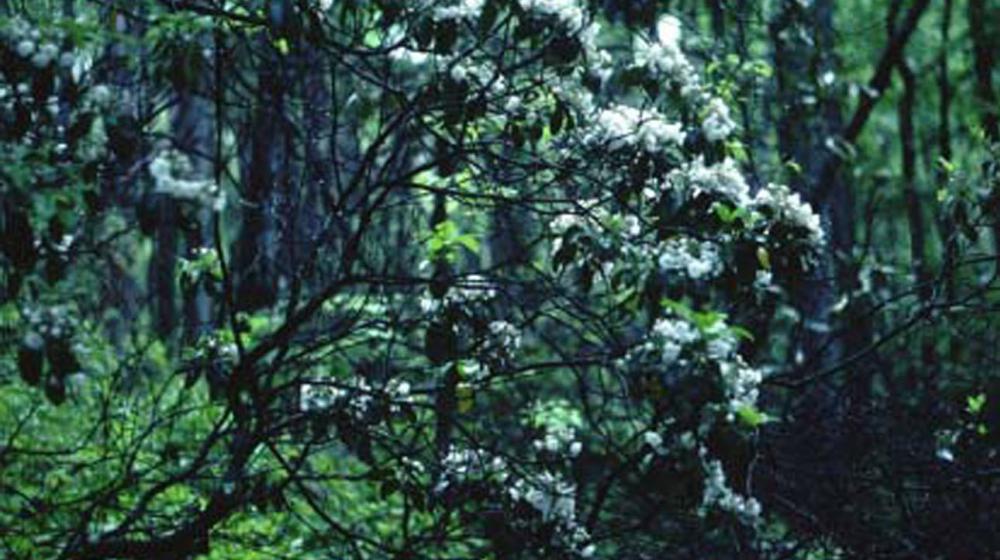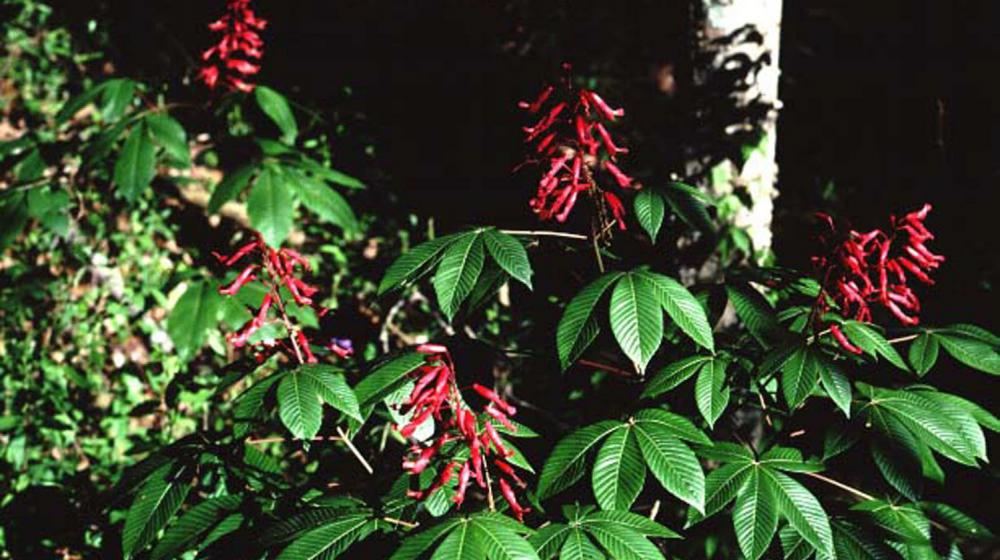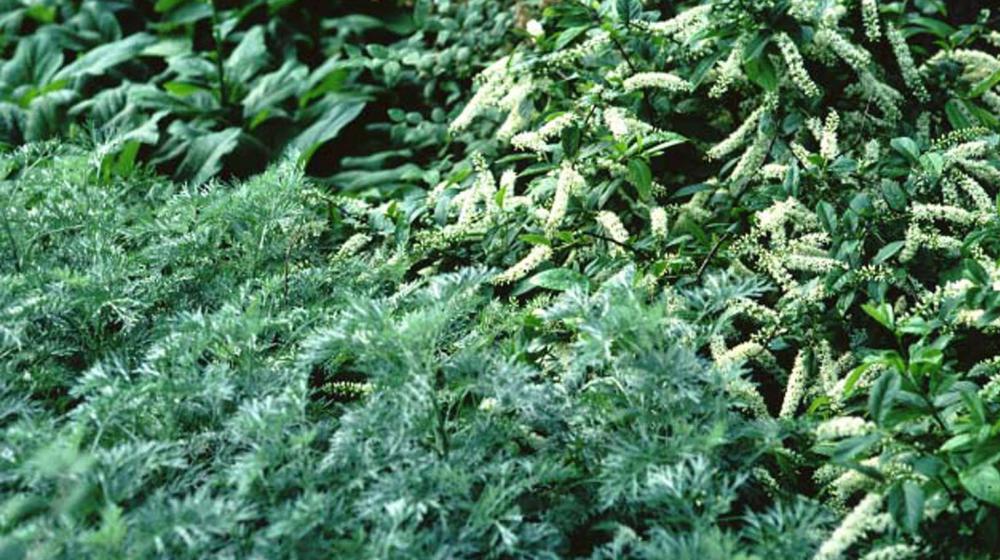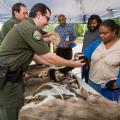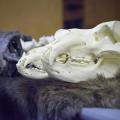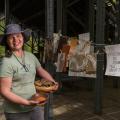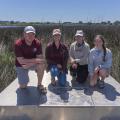Native Shrubs for Mississippi Landscapes
The following list describes thirty shrub species that are native to Mississippi and have proven to perform well in urban landscapes. For each shrub species described, its native habitats; flowering, fruit, leaf and form characteristics; wildlife values; cultural tips; as well as effective landscape uses are noted. While many of these plants tolerate conditions not found in their native environment, it is always preferable to choose plants that are best suited to the site. Most of these plants are being produced in area wholesale nurseries, ask your local nurseryman about their availability.
Shrubs are listed by:
- Common Name
- Scientific Name and Author
- Family Name
Red Buckeye
Aesculus pavia Linnaeus
Hippocastanaceae
Red buckeye is a small deciduous shrub in the Deep South. Rarely exceeding ten feet in height, red buckeye is found growing on the well-drained slopes of creekbanks and rivers. Large, showy red flower spikes appear on the ends of branches in March and April, and are a favorite food source for hummingbirds. It forms a broad mounding shrub, and will form large colonies from root suckers. Often it is defoliated in midsummer from leaf anthracnose, but does not injure the plant. Red buckeye has handsome palmate compound leaves that exhibit yellow fall color. Plant buckeye in shrub masses underneath canopy trees for a naturalistic look.
Sun to shade/dry to moist soils/deciduous/medium wildlife value/spring flowers
Tag Alder
Alnus serrulata (Ait.) Willd.
Betulaceae
This tall deciduous shrub can reach up to fifteen feet in height. Tag alder is commonly found in the wet acid soils of branch bottoms and flatwoods. The leaves are elliptic in shape and have a fine toothed edge. This alder produces long, thin 'catkin' flowers in late fall, which are conspicuously showy in early spring. The shrub has a twisting crooked trunk and makes an excellent specimen shrub. The seeds are eaten by several bird species, and the stems and leaves are consumed by deer and beaver.
Sun to shade/wet or moist soils/deciduous/medium wildlife value/spring flowers
Groundsel Bush
Baccharis halimifolia Linnaeus
Compositae
Groundsel bush is a finely branched evergreen shrub that reaches twelve feet in height and approximately six feet wide. It is an early colonizer plant of the wet soils of marshes, fields, and swamp areas. This shrub has a loose irregular form reminiscent of wax myrtle. It blooms in early fall with numerous billowy white flowers that cover the plant. These flowers are a favorite nectar source for many butterfly species. Tolerant of both salt- and freshwater areas, this shrub readily adapts to any sunny site.
Sun to part sun/wet or dry soils/evergreen/high wildlife value/fall flowers
American Beautyberry
Callicarpa americana Linnaeus
Verbenaceae
This beautiful deciduous shrub can reach up to eight feet in height and nearly six feet wide. Beautyberry has a broad coarse leaf texture and turns bright yellow in fall. Commonly found at woodland edges and along fencerows, it is tolerant of most soil types. Small rosy flowers appear along the branches in May, which form very showy bright purple fruits in late summer. These fruits are eaten by many species of birds and mammals. Beautyberry has a broad mounding form in full sunlight, and is effective in shrub masses or as a specimen plant.
Sun to part shade/dry to moist soils/deciduous/high wildlife value/showy fall fruit
Sweetshrub
Calycanthus floridus Linneaus
Calycanthaceae
Sweetshrub is a medium-sized deciduous shrub that can reach eight feet in height and four feet in width. It is occasionally found on drier soil types in fertile woodlands, and along sandy streams and hillsides. This shrub has an attractive ovate leaf with very prominent veins, and forms a bright yellow fall color. Sweetshrub has a sweetly fragrant reddish brown flower in late spring. This upright shrub is effective in masses and hedgerows in naturalistic settings.
Sun to part shade/dry to moist soils/deciduous/low wildlife value/spring flowers
Buttonbush
Cephalanthus occidentalis Linneaus
Rubiaceae
Buttonbush is a deciduous shrub that grows to ten feet in height. Found in wet soils near swamps, ponds and lakes. This shrub has an interesting open, sprawling form and can occur in colonies. An unusual white globe flower is produced throughout the summer months, which is visited by bees and butterflies. The flower forms a round seedhead in fall which is eaten by several bird species. This is a good shrub for shallow water areas at the edges of ponds.
Sun to part sun/wet or dry soils/deciduous/high wildlife value/summer flowers
 Fringe Tree
Fringe Tree
Chionanthus virginicus Linnaeus
Oleaceae
Fringe tree is a large deciduous shrub or small tree that reaches twenty feet in height and twelve feet wide. It is found in upland pine forests on well-drained soil. Often multiple-trunked, it has a rounded shrubby form. Fringe tree blooms in spring, with white fringelike petals that have a slight fragrance. Small blue fruits are produced in late summer and are consumed by numerous birds and wildlife. The large oval leaves have a yellow autumn color. Fringe tree is an excellent specimen tree for the home landscape. See larger view or publication size.
Sun to part sun/dry to moist soils/deciduous/high wildlife value/spring flowers
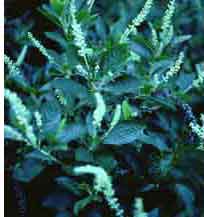 Summersweet
Summersweet
Clethra alnifolia Linnaeus
Clethraceae
Summersweet is a deciduous shrub that averages six feet in height and four feet wide. It is found in moist acid soils of wet pine savannas, bogs and pocosins. The attractive dark green leaves are toothed and have a yellow fall color. Sweetly fragrant white bloom spikes appear in early summer for several weeks. Summersweet has an upright form with medium textured foliage, and is excellent for use in naturalistic plantings. Seelarger view or publication size.
Sun to part sun/wet or dry soils/deciduous/medium wildlife value/summer flowers
Buckwheat Tree
Cliftonia monophylla Gaertner
Cyrillaceae
Buckwheat tree is a large evergreen shrub that can reach twenty feet tall and wide. It is found in the moist acid soils of swamps, bogs and wet pinelands. Buckwheat has an upright oval form with multiple trunks. White flower clusters appear at the ends of branches in winter and persist well into spring. Yellow 'buckwheat' fruits appear in summer and are somewhat prominent.
Sun to part sun/wet or dry soils/evergreen/medium wildlife value/winter flowers
Witch Alder
Fothergilla major (Sims) Lodd.
Hamamelidaceae
Witch alder is a deciduous shrub that reaches eight feet in height and five feet in width. It is occasionally found in well-drained acid soils of dry woods. Witch alder has an upright to pyramidal form and is effective as an understory shrub in naturalistic settings. The large toothed leaves have a red or orange fall color. Creamy-white bottlebrush flowers have a sweet fragrance, and appear in early spring.
Part shade to shade/dry to moist soils/deciduous/low wildlife value/spring flowers
Dwarf Huckleberry
Gaylussacia dumosa (Andrz.) T & G
Ericaceae
Dwarf huckleberry is a deciduous shrub that can reach six feet in height and four feet wide. It is found in a variety of acid soil woodlands, including pine savannas and bogs. This huckleberry has an upright to mounding form and is often sculptural. The small fine textured leaves turn a brilliant red color in autumn. Small pink flowers bloom in winter and produces small edible huckleberry fruits in early summer. These fruits are prized by a variety of birds and other wildlife.
Sun to part sun/dry to wet soils/deciduous/high wildlife value/summer fruits
Witch Hazel
Hamamelis virginiana Linnaeus
Hamamelidaceae
Witch hazel is a large deciduous shrub to small tree that may reach fifteen feet tall. It is found in a variety of rich woodlands and along streambanks. The large scalloped leaves are attractive in summer, and produce a yellow autumn color. The shrub has strap-like yellow flower petals that are fragrant, and bloom from fall into winter. Witch hazel has a spreading sculptural form and is effective in the landscape as an understory specimen plant.
Sun or shade/dry to moist soils/deciduous/low wildlife value/winter flowers
Oakleaf Hydrangea
Hydrangea quercifolia Bartram
Hydrangeaceae
An excellent deciduous shrub with many ornamental qualities, oakleaf hydrangea grows to six feet in height and four feet wide. This species is found in fertile well-drained woodlands of the state. The leaves are large and oak-like, which turn a rich purple color in the fall. Oakleaf hydrangea flowers in late spring, and are large and creamy-white. This plant is an excellent specimen plant for shady areas under larger trees in well-drained soil conditions.
Part shade to shade/well drained fertile soils/deciduous/low wildlife value/spring flowers
Bigleaf Gallberry Holly
Ilex coriaceae (Pursh) Chapman
Aquifoliaceae
A large evergreen shrub that can reach fifteen feet in height, bigleaf gallberry holly is native to wetland soils of pine flatwoods, swamp edges and bogs. This holly tends to be upright in form with multiple stems, and makes an excellent hedge or barrier plant. Large shiny black fruits are produced in fall and winter. These holly fruits are utilized by a number of birds and small mammals. This is a good tough holly that is tolerant of many extreme environments.
Sun to part sun/wet or dry soils/evergreen/high wildlife value/winter fruits
Winterberry Holly
Ilex verticillata (L.) Gray
Aquifoliaceae
Winterberry holly is a deciduous shrub that can reach ten feet in height and six feet wide. It has an open wide-spreading form with arching branches. This holly is found in wet woods, bogs, and along streamsides. The showy winter fruit is a large red berry that persists well through winter. It is an excellent specimen plant for courtyards and gardens.
Sun to part sun/wet or dry soils/deciduous/high wildlife value/winter fruits
Star Anise
Illicium floridanum Ell.
Illicaceae
Star anise is an evergreen shrub that grows to eight feet in height and six feet wide. It is commonly found growing in dense thickets along streambanks and moist woods. Star anise has an upright oval form with deep green leaves of coarse texture. The leaves are heavily scented and noticeable when encountered. Deep maroon starry flowers cover the plant in early spring. This plant is a good landscape plant for shady well-drained or moist soils.
Shade to part shade/dry to moist soils/low wildlife value/spring flowers
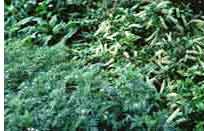 Virginia Sweetspire
Virginia Sweetspire
Itea virginica Linneaus
Saxifragaceae
A deciduous shrub that reaches five feet in height and three feet wide, sweetspire is found along stream edges and swamps. It has an upright to spreading form with multiple stems. The medium textured leaves turn a deep wine red in the autumn. Fragrant white flower clusters appear at the ends of branches in April and May. This shrub is very tolerant of many different garden conditions and several cultivars are available. See larger view or publication size.
Sun to part sun/dry or wet soils/medium wildlife value/spring flowers
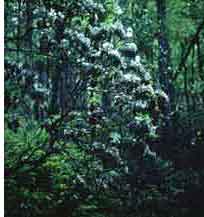 Mountain Laurel
Mountain Laurel
Kalmia latifolia Linnaeus
Ericaceae
Mountain laurel is an evergreen shrub that often reaches ten feet in height and width. It grows on the slopes of rivers and creekbanks across the eastern United States. Mountain laurel has an open broad spreading form with multiple branches. The foliage is dark green of medium texture, and is slow growing. Exquisite pink wheel-shaped flowers cover the plant in spring. Older plants exhibit an attractive reddish brown exfoliating bark. Seelarger view or publication size.
Shade to part shade/dry to moist soils/low wildlife value/spring flowers
Leucothoe
Leucothoe axillaris (Lam.) D. Don
Ericaceae
Leucothoe is a small evergreen shrub that grows to three feet in height and width. It is a low spreading shrub with arching stems of loose form. It is found growing in wet acid soils near swamps, bogs and creekbeds. Small white fragrant flowers cluster along the flower stem from late winter to mid-spring. This evergreen shrub has few insect or disease problems and is well suited to the home landscape.
Part sun to shade/dry or wet soils/low wildlife value/spring flowers
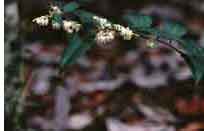 Lyonia
Lyonia
Lyonia lucida (Lam.) Koch
Ericaceae
This evergreen shrub averages three feet in height and spread. Found growing along well-drained sandy woodlands and streams, it is widely tolerant of many growing conditions. Small nodding bell-shaped white flowers cluster along the stems in late spring. Lyonia has a low mounding form with arching branches. There are few problems associated with lyonia, and it is useful as an understory shrub. See larger view or publication size.
Part sun to shade/dry or moist soils/low wildlife value/spring flowers
American Sweet Olive
Osmanthus americanus (L.) Gray
Oleaceae
An evergreen shrub that reaches up to twenty feet in height and ten feet wide, American sweet olive is the native version of the more common Asian species. Found in dry acid soils of pinelands, this shrub has an oval open form. Rather than blooming in winter as the Chinese sweet olive does, this native plant blooms in early spring. Small white flowers bloom on the new wood and are not as heavily fragrant as the common ornamental. This shrub has few problems or pests, and is useful as a hedge or screen.
Sun to part shade/dry or moist soils/low wildlife value/spring flowers
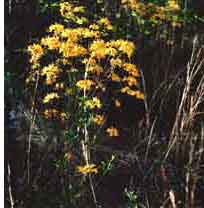 Yellow Native Azalea
Yellow Native Azalea
Rhododendron austrinum (Sm.) Rehd.
Ericaceae
This magnificent deciduous shrub grows to twelve feet in height and eight feet wide. Native to rich well drained woodlands along streams and rivers, it performs best in morning sun or filtered light. Rich yellow or orange fragrant blossoms appear for three weeks in April and May. Yellow native azalea is sensitive to wet or poorly drained soil types, but has few other problems. There are many cultivars available that exhibit different flower forms and colors. See larger view or publication size.
Part sun to shade/dry to moist soils/low wildlife value/spring flowers
 Honeysuckle Azalea
Honeysuckle Azalea
Rhododendron canescens (Michx.) Sweet
Ericaceae
A beautiful deciduous shrub that grows to twelve feet in height and eight feet in width. This azalea is widely found along streambanks and rivers of the state. It performs best in a filtered light, the foliage tends to burn in full sun. The large fragrant flower clusters range from pure white to dark pink, and bloom from late March to early April. This azalea is more adaptive of soil types than the yellow native azalea, and there are many cultivar types available. See larger view or publication size.
Part sun to shade/dry to moist soils/low wildlife value/spring flowers
Summer Azalea
Rhododendron serrulatum (SM.) Mill.
Ericaceae
Summer azalea is a deciduous shrub that grows to fifteen feet in height and about ten feet wide. Native to floodplains along streams, this azalea is tolerant of wet soils. Rather than blooming in spring as other azaleas, this species blooms from June through August with extremely fragrant white flowers. This azalea tolerates and blooms well in heavily shaded locations.
Part shade to shade/moist to wet soils/low wildlife value/summer flowers
Staghorn Sumac
Rhus typhina L.
Anacardiaceae
Staghorn sumac is a tall deciduous shrub that reaches twenty feet in height and width. It is found in dry soil types along roadsides, and in fields and pastures. The long pinnate leaves are attractive, and turn a bright orange or red in autumn. Green flower clusters appear on the plant in early summer, and mature to rich red fruits in late summer which often persist through winter. This is a tough, versatile shrub for difficult soil types. It often forms broad colonies through root suckering.
Sun to part sun/dry to moist soils/high wildlife value/late summer fruits
Dwarf Palmetto
Sabal minor (Jacq.) Pers.
Arecaceae
This versatile evergreen shrub grows to six feet in height and four feet wide. Found primarily in river floodplains, this shrub can grow in a wide variety of wet or dry soil types. Dwarf palmetto has a tropical leaf, and is an excellent understory shrub groundcover or focal plant. Round black fruits appear on long stems in late summer, and persist through winter. Few insects or diseases are associated with this species.
Sun to shade/dry or wet soils/medium wildlife value/late summer fruits
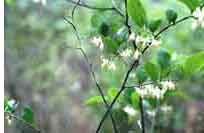 Snowbell
Snowbell
Styrax americana Lam.
Styraceaceae
A little known deciduous shrub, snowbell grows to a height of ten feet and six feet wide. It is found in wet soils of bottomland hardwood forests and along stream edges. Small white flowers are numerous on the plant, and bloom from April through May. It typically has an upright oval form. See larger view or publication size.
Sun to part sun/wet or moist soils/medium wildlife value/spring flowers
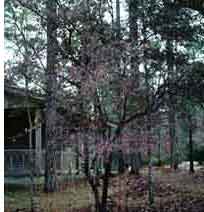 Tree Huckleberry
Tree Huckleberry
Vaccinium arboreum Marshall
Ericaceae
This large semi-evergreen shrub reaches twenty feet in height and fifteen feet wide. It is found in a wide range of woodland types, and from dry sandy soils to moist stream edges. Small bell-shaped white flowers appear on the plant from April through May, and are followed by small black fruits in early fall. The fruits are highly utilized by song and game birds, deer, and numerous small mammals. The upright form of this plant lends for use as a small ornamental tree, and exhibits an attractive peeling red bark. See larger view or publication size.
Sun to part sun/dry to moist soils/high wildlife value/spring flowers/summer fruits
Elliott's Blueberry
Vaccinium elliottii Chapm.
Ericaceae
This wild blueberry is a deciduous shrub that grows to twelve feet in height and spread. It is found in open pinelands, marshy edges, and along streams and roadsides. Small white blueberry flowers bloom from March through May, and are followed by small edible black fruits in early summer. The shrub has a loose rounded form, and often exhibits bright green stems. The green leaves are small, and have a bright red fall color. Few insect or disease problems have been observed.
Sun to part sun/moist to wet soils/high wildlife value/spring flowers/summer fruits
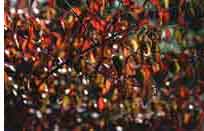 Arrow-wood Viburnum
Arrow-wood Viburnum
Viburnum dentatum L.
Caprifoliaceae
Arrow-wood viburnum is a large deciduous shrub that reaches twenty feet in height and ten feet in width. It is found in acid soils of the state in the moist soils of swamp forests and alluvial woods. Arrow-wood has an attractive toothed leaf, that turns yellow and red in late fall. White flower clusters appear in March through May, and are followed by numerous blue fruits in late summer. These fruits are used by many birds and mammals. The narrow upright form of long thin branches make it a useful shrub for narrow beds and courtyard plantings. See larger view or publication size.
Sun to part sun/dry to wet soils/high wildlife value/spring flowers/summer fruits
Publications
News
An underserved community spent a day enjoying the outdoors at the Sam D. Hamilton Noxubee National Wildlife Refuge in early May as Mississippi State University Extension Service personnel hosted 20 adult residents of care homes.
Jim McAdory, MSU Extension agent in Winston County, coordinated the May 1 event with help from several other Extension agents and U.S. Fish and Wildlife Service staff. The goal was to allow this population to experience the outdoors, complete with a hot dog lunch at the end of the event.
PICAYUNE, Miss. -- School groups, nature enthusiasts and the public can enjoy two fun-filled days of exciting, hands-on learning about the environment, ecosystems, wildlife and insects at the Mississippi State University Crosby Arboretum in Picayune. BugFest offers insect-related displays, interactive exhibits, games and crafts. Biologists, naturalists, entomologists and other experts from Mississippi, Louisiana and Alabama will host booths and give presentations on butterflies, bats, caterpillars, beetles, crayfish, ladybugs, hissing cockroaches, dancing praying mantises, native and exotic arthropods and more.
Two conservation camps this summer offer students in grades six through 12 the opportunity to gain hands-on experience in wildlife science, outdoor recreation and conservation careers. Conservation Camp 2022 has a residential edition June 5-8 for rising eighth through 12th graders. The day camp edition is June 13-15 for rising sixth through eighth graders.
Success Stories
More than 80 grade-school students from Choctaw Tribal Schools visited Mississippi State University in March to participate in Choctaw Preview Day.
Robin Whitfield, who gave the child the paper, stands awestruck, watching her friend’s daughter use the flower to draw and color on the page.
Mississippi State University and partners have been awarded a grant of nearly $6.6 million from the National Fish and Wildlife Federation for shoreline restoration work on the Gulf Coast.

